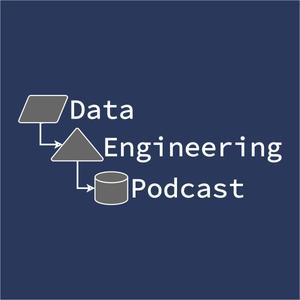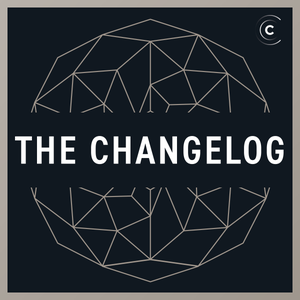
Streaming Audio: Apache Kafka® & Real-Time Data
Confluent, founded by the original creators of Apache Kafka®
Streaming Audio features all things Apache Kafka®, Confluent, real-time data, and the cloud. We cover frequently asked questions, best practices, and use cases from the Kafka community—from Kafka connectors and distributed systems, to data mesh, data integration, modern data architectures, and data mesh built with Confluent and cloud Kafka as a service. Join host Kris Jenkins (Senior Developer Advocate, Confluent) as he streams through a series of interviews, stories, and use cases with guests from the data streaming industry. Apache®️, Apache Kafka, Kafka, and the Kafka logo are either registered trademarks or trademarks of the Apache Software Foundation in the United States and/or other countries. No endorsement by The Apache Software Foundation is implied by the use of these marks.
- 11 minutes 25 secondsApache Kafka 3.5 - Kafka Core, Connect, Streams, & Client Updates
Apache Kafka® 3.5 is here with the capability of previewing migrations between ZooKeeper clusters to KRaft mode. Follow along as Danica Fine highlights key release updates.
Kafka Core:- KIP-833 provides an updated timeline for KRaft.
- KIP-866 now is preview and allows migration from an existing ZooKeeper cluster to KRaft mode.
- KIP-900 introduces a way to bootstrap the KRaft controllers with SCRAM credentials.
- KIP-903 prevents a data loss scenario by preventing replicas with stale broker epochs from joining the ISR list.
- KIP-915 streamlines the process of downgrading Kafka's transaction and group coordinators by introducing tagged fields.
Kafka Connect:- KIP-710 provides the option to use a REST API for internal server communication that can be enabled by setting `dedicated.mode.enable.internal.rest` equal to true.
- KIP-875 offers support for native offset management in Kafka Connect. Connect cluster administrators can now read offsets for both source and sink connectors. This KIP adds a new STOPPED state for connectors, enabling users to shut down connectors and maintain connector configurations without utilizing resources.
- KIP-894 makes `IncrementalAlterConfigs` API available for use in MirrorMaker 2 (MM2), adding a new use.incremental.alter.config configuration which takes values “requested,” “never,” and “required.”
- KIP-911 adds a new source tag for metrics generated by the `MirrorSourceConnector` to help monitor mirroring deployments.
Kafka Streams:- KIP-339 improves Kafka Streams' error-handling capabilities by addressing serialization errors that occur before message production and extending the interface for custom error handling.
- KIP-889 introduces versioned state stores in Kafka Streams for temporal join semantics in stream-to-table joins.
- KIP-904 simplifies table aggregation in Kafka by proposing a change in serialization format to enable one-step aggregation and reduce noise from events with old and new keys/values.
- KIP-914 modifies how versioned state stores are used in Kafka Streams. Versioned state stores may impact different DSL processors in varying ways, see the documentation for details.
Kafka Client:- KIP-881 is now complete and introduces new client-side assignor logic for rack-aware consumer balancing for Kafka Consumers.
- KIP-887 adds the `EnvVarConfigProvider` implementation to Kafka so custom configurations stored in environment variables can be injected into the system by providing the map returned by `System.getEnv()`.
- KIP 641 introduces the `RecordReader` interface to Kafka's clients module, replacing the deprecated MessageReader Scala trait.
EPISODE LINKS- See release notes for Apache Kafka 3.5
- Read the blog to learn more
- Download and get started with Apache Kafka 3.5
- Watch the video version of this podcast
15 June 2023, 4:00 pm - 1 minute 18 secondsA Special Announcement from Streaming Audio
After recording 64 episodes and featuring 58 amazing guests, the Streaming Audio podcast series has amassed over 130,000 plays on YouTube in the last year. We're extremely proud of these achievements and feel that it's time to take a well-deserved break. Streaming Audio will be taking a vacation! We want to express our gratitude to you, our valued listeners, for spending 10,000 hours with us on this incredible journey.
Rest assured, we will be back with more episodes! In the meantime, feel free to revisit some of our previous episodes. For instance, you can listen to Anna McDonald share her stories about the worst Apache Kafka® bugs she’s ever seen, or listen to Jun Rao offer his expert advice on running Kafka in production. And who could forget the charming backstory behind Mitch Seymour's Kafka storybook, Gently Down the Stream?
These memorable episodes brought us joy, and we're thrilled to have shared them with you. As we reflect on our accomplishments with pride, we also look forward to an exciting future. Until we meet again, happy listening!
EPISODE LINKS- Top 6 Worst Apache Kafka JIRA Bugs
- Running Apache Kafka in Production
- Learn How Stream-Processing Works The Simplest Way Possible
- Watch the video version of this podcast
- Streaming Audio Playlist
- Join the Confluent Community
- Learn more with Kafka tutorials, resources, and guides at Confluent Developer
- Live demo: Intro to Event-Driven Microservices with Confluent
- Use PODCAST100 to get an additional $100 of free Confluent Cloud usage (details)
13 April 2023, 7:00 am - 57 minutes 28 secondsHow to use Data Contracts for Long-Term Schema Management
Have you ever struggled with managing data long term, especially as the schema changes over time? In order to manage and leverage data across an organization, it’s essential to have well-defined guidelines and standards in place around data quality, enforcement, and data transfer. To get started, Abraham Leal (Customer Success Technical Architect, Confluent) suggests that organizations associate their Apache Kafka® data with a data contract (schema). A data contract is an agreement between a service provider and data consumers. It defines the management and intended usage of data within an organization. In this episode, Abraham talks to Kris about how to use data contracts and schema enforcement to ensure long-term data management.
When an organization sends and stores critical and valuable data in Kafka, more often than not it would like to leverage that data in various valuable ways for multiple business units. Kafka is particularly suited for this use case, but it can be problematic later on if the governance rules aren’t established up front.
With schema registry, evolution is easy due to its robust security guarantees. When managing data pipelines, you can also use GitOps automation features for an extra control layer. It allows you to be creative with topic versioning, upcasting/downcasting the data collected, and adding quality assurance steps at the end of each run to ensure your project remains reliable.
Abraham explains that Protobuf and Avro are the best formats to use rather than XML or JSON because they are built to handle schema evolution. In addition, they have a much lower overhead per-record, so you can save bandwidth and data storage costs by adopting them.
There’s so much more to consider, but if you are thinking about implementing or integrating with your data quality team, Abraham suggests that you use schema registry heavily from the beginning.
If you have more questions, Kris invites you to join the conversation. You can also watch the KOR Financial Current talk Abraham mentions or take Danica Fine’s free course on how to use schema registry on Confluent Developer.
EPISODE LINKS- OS project
- KOR Financial Current Talk
- The Key Concepts of Schema Registry
- Schema Evolution and Compatibility
- Schema Registry Made Simple by Confluent Cloud ft. Magesh Nandakumar
- Kris Jenkins’ Twitter
- Watch the video version of this podcast
- Streaming Audio Playlist
- Join the Confluent Community
- Learn more with Kafka tutorials, resources, and guides at Confluent Developer
- Live demo: Intro to Event-Driven Microservices with Confluent
- Use PODCAST100 to get an additional $100 of free Confluent Cloud usage (details)
21 March 2023, 7:00 am - 31 minutes 57 secondsHow to use Python with Apache Kafka
Can you use Apache Kafka® and Python together? What’s the current state of Python support? And what are the best options to get started? In this episode, Dave Klein joins Kris to talk about all things Kafka and Python: the libraries, the tools, and the pros & cons. He also talks about the new course he just launched to support Python programmers entering the event-streaming world.
Dave has been an active member of the Kafka community for many years and noticed that there were a lot of Kafka resources for Java but few for Python. So he decided to create a course to help people get started using Python and Kafka together.
Historically, Java has had the most documentation, and people have often missed how good the Python support is for Kafka users. Python and Kafka are an ideal fit for machine learning applications and data engineering in general. Yet there are a lot of use cases for building, streaming, and machine learning pipelines. In fact, someone conducted a survey to find out what languages were most popular in the Kafka community and Python came in second after Java. That’s how Dave got the idea to create a course for newbies.
In this course, Dave combines video lectures with code-heavy exercises to give developers a taste of what the code looks like, how to structure it, a preview of the shape of the code, and the structure of the classes and the functions so you can get hands-on practice using the library. He also covers building a producer and a consumer and using the admin client. And, of course, there is a module that covers working with the schemas supported by the Kafka library.
Dave explains that Python opens up a world of opportunity and is ripe for expansion. So if you are ready to dive in, head over to developer.confluent.io to learn more about Dave’s course.
EPISODE LINKS- Blog: Getting Started with Python for Apache Kafka
- Course: Introduction to Apache Kafka for Python Developers
- Step-by-step guide: Building a Python client application for Kafka
- Coding in Motion
- Building and Designing Events and Event Streams with Apache Kafka
- Watch the video version of this podcast
- Kris Jenkins’ Twitter
- Streaming Audio Playlist
- Join the Confluent Community
- Learn more with Kafka tutorials, resources, and guides at Confluent Developer
- Live demo: Intro to Event-Driven Microservices with Confluent
- Use PODCAST100 to get an additional $100 of free Confluent Cloud usage (details)
14 March 2023, 7:00 am - 55 minutes 55 secondsNext-Gen Data Modeling, Integrity, and Governance with YODA
In this episode, Kris interviews Doron Porat, Director of Infrastructure at Yotpo, and Liran Yogev, Director of Engineering at ZipRecruiter (formerly at Yotpo), about their experiences and strategies in dealing with data modeling at scale.
Yotpo has a vast and active data lake, comprising thousands of datasets that are processed by different engines, primarily Apache Spark™. They wanted to provide users with self-service tools for generating and utilizing data with maximum flexibility, but encountered difficulties, including poor standardization, low data reusability, limited data lineage, and unreliable datasets.
The team realized that Yotpo's modeling layer, which defines the structure and relationships of the data, needed to be separated from the execution layer, which defines and processes operations on the data.
This separation would give programmers better visibility into data pipelines across all execution engines, storage methods, and formats, as well as more governance control for exploration and automation.
To address these issues, they developed YODA, an internal tool that combines excellent developer experience, DBT, Databricks, Airflow, Looker and more, with a strong CI/CD and orchestration layer.
Yotpo is a B2B, SaaS e-commerce marketing platform that provides businesses with the necessary tools for accurate customer analytics, remarketing, support messaging, and more.
ZipRecruiter is a job site that utilizes AI matching to help businesses find the right candidates for their open roles.
EPISODE LINKS- Current 2022 Talk: Next Gen Data Modeling in the Open Data Platform
- Data Mesh 101
- Data Mesh Architecture: A Modern Distributed Data Model
- Watch the video version of this podcast
- Kris Jenkins’ Twitter
- Streaming Audio Playlist
- Join the Confluent Community
- Learn more with Kafka tutorials, resources, and guides at Confluent Developer
- Live demo: Intro to Event-Driven Microservices with Confluent
- Use PODCAST100 to get an additional $100 of free Confluent Cloud usage (details)
7 March 2023, 8:00 am - 1 hour 1 minuteMigrate Your Kafka Cluster with Minimal Downtime
Migrating Apache Kafka® clusters can be challenging, especially when moving large amounts of data while minimizing downtime. Michael Dunn (Solutions Architect, Confluent) has worked in the data space for many years, designing and managing systems to support high-volume applications. He has helped many organizations strategize, design, and implement successful Kafka cluster migrations between different environments. In this episode, Michael shares some tips about Kafka cluster migration with Kris, including the pros and cons of the different tools he recommends.
Michael explains that there are many reasons why companies migrate their Kafka clusters. For example, they may want to modernize their platforms, move to a self-hosted cloud server, or consolidate clusters. He tells Kris that creating a plan and selecting the right tool before getting started is critical for reducing downtime and minimizing migration risks.
The good news is that a few tools can facilitate moving large amounts of data, topics, schemas, applications, connectors, and everything else from one Apache Kafka cluster to another.
Kafka MirrorMaker/MirrorMaker2 (MM2) is a stand-alone tool for copying data between two Kafka clusters. It uses source and sink connectors to replicate topics from a source cluster into the destination cluster.
Confluent Replicator allows you to replicate data from one Kafka cluster to another. Replicator is similar to MM2, but the difference is that it’s been battle-tested.
Cluster Linking is a powerful tool offered by Confluent that allows you to mirror topics from an Apache Kafka 2.4/Confluent Platform 5.4 source cluster to a Confluent Platform 7+ cluster in a read-only state, and is available as a fully-managed service in Confluent Cloud.
At the end of the day, Michael stresses that coupled with a well-thought-out strategy and the right tool, Kafka cluster migration can be relatively painless. Following his advice, you should be able to keep your system healthy and stable before and after the migration is complete.
EPISODE LINKS- MirrorMaker 2
- Replicator
- Cluster Linking
- Schema Migration
- Multi-Cluster Apache Kafka with Cluster Linking
- Watch the video version of this podcast
- Kris Jenkins’ Twitter
- Streaming Audio Playlist
- Join the Confluent Community
- Learn more with Kafka tutorials, resources, and guides at Confluent Developer
- Live demo: Intro to Event-Driven Microservices with Confluent
- Use PODCAST100 to get an additional $100 of free Confluent Cloud usage (details)
1 March 2023, 8:00 am - 43 minutes 41 secondsReal-Time Data Transformation and Analytics with dbt Labs
dbt is known as being part of the Modern Data Stack for ELT processes. Being in the MDS, dbt Labs believes in having the best of breed for every part of the stack. Oftentimes folks are using an EL tool like Fivetran to pull data from the database into the warehouse, then using dbt to manage the transformations in the warehouse. Analysts can then build dashboards on top of that data, or execute tests.
It’s possible for an analyst to adapt this process for use with a microservice application using Apache Kafka® and the same method to pull batch data out of each and every database; however, in this episode, Amy Chen (Partner Engineering Manager, dbt Labs) tells Kris about a better way forward for analysts willing to adopt the streaming mindset: Reusable pipelines using dbt models that immediately pull events into the warehouse and materialize as materialized views by default.dbt Labs is the company that makes and maintains dbt. dbt Core is the open-source data transformation framework that allows data teams to operate with software engineering’s best practices. dbt Cloud is the fastest and most reliable way to deploy dbt.
Inside the world of event streaming, there is a push to expand data access beyond the programmers writing the code, and towards everyone involved in the business. Over at dbt Labs they’re attempting something of the reverse— to get data analysts to adopt the best practices of software engineers, and more recently, of streaming programmers. They’re improving the process of building data pipelines while empowering businesses to bring more contributors into the analytics process, with an easy to deploy, easy to maintain platform. It offers version control to analysts who traditionally don’t have access to git, along with the ability to easily automate testing, all in the same place.
In this episode, Kris and Amy explore:- How to revolutionize testing for analysts with two of dbt’s core functionalities
- What streaming in a batch-based analytics world should look like
- What can be done to improve workflows
- How to democratize access to data for everyone in the business
EPISODE LINKS
- Learn more about dbt labs
- An Analytics Engineer’s Guide to Streaming
- Panel discussion: If Streaming Is the Answer, Why Are We Still Doing Batch?
- All Current 2022 sessions and slides
- Watch the video version of this podcast
- Kris Jenkins’ Twitter
- Streaming Audio Playlist
- Join the Confluent Community
- Learn more with Kafka tutorials, resources, and guides at Confluent Developer
- Live demo: Intro to Event-Driven Microservices with Confluent
- Use PODCAST100 to get an additional $100 of free Confluent Cloud usage (details)
22 February 2023, 8:00 am - 41 minutes 29 secondsWhat is the Future of Streaming Data?
What’s the next big thing in the future of streaming data? In this episode, Greg DeMichillie (VP of Product and Solutions Marketing, Confluent) talks to Kris about the future of stream processing in environments where the value of data lies in their ability to intercept and interpret data.
Greg explains that organizations typically focus on the infrastructure containers themselves, and not on the thousands of data connections that form within. When they finally realize that they don't have a way to manage the complexity of these connections, a new problem arises: how do they approach managing such complexity? That’s where Confluent and Apache Kafka® come into play - they offer a consistent way to organize this seemingly endless web of data so they don't have to face the daunting task of figuring out how to connect their shopping portals or jump through hoops trying different ETL tools on various systems.
As more companies seek ways to manage this data, they are asking some basic questions:- How to do it?
- Do best practices exist?
- How can we get help?
The next question for companies who have already adopted Kafka is a bit more complex: "What about my partners?” For example, companies with inventory management systems use supply chain systems to track product creation and shipping. As a result, they need to decide which emails to update, if they need to write custom REST APIs to sit in front of Kafka topics, etc. Advanced use cases like this raise additional questions about data governance, security, data policy, and PII, forcing companies to think differently about data.
Greg predicts this is the next big frontier as more companies adopt Kafka internally. And because they will have to think less about where the data is stored and more about how data moves, they will have to solve problems to make managing all that data easier. If you're an enthusiast of real-time data streaming, Greg invites you to attend the Kafka Summit (London) in May and Current (Austin, TX) for a deeper dive into the world of Apache Kafka-related topics now and beyond.
EPISODE LINKS- What’s Ahead of the Future of Data Streaming?
- If Streaming Is the Answer, Why Are We Still Doing Batch?
- All Current 2022 sessions and slides
- Kafka Summit London 2023
- Current 2023
- Watch the video version of this podcast
- Kris Jenkins’ Twitter
- Streaming Audio Playlist
- Join the Confluent Community
- Learn more with Kafka tutorials, resources, and guides at Confluent Developer
- Live demo: Intro to Event-Driven Microservices with Confluent
- Use PODCAST100 to get an additional $100 of free Confluent Cloud usage (details)
15 February 2023, 8:00 am - 55 minutes 32 secondsWhat can Apache Kafka Developers learn from Online Gaming?
What can online gaming teach us about making large-scale event management more collaborative in real-time? Ben Gamble (Developer Relations Manager, Aiven) has come to the world of real-time event streaming from an usual source: the video games industry. And if you stop to think about it, modern online games are complex, distributed real-time data systems with decades of innovative techniques to teach us.
In this episode, Ben talks with Kris about integrating gaming concepts with Apache Kafka®. Using Kafka’s state management stream processing, Ben has built systems that can handle real-time event processing at a massive scale, including interesting approaches to conflict resolution and collaboration.
Building latency into a system is one way to mask data processing time. Ben says that you can efficiently hide latency issues and prioritize performance improvements by setting an initial target and then optimizing from there. If you measure before optimizing, you can add an extra layer to manage user expectations better. Tricks like adding a visual progress bar give the appearance of progress but actually hide latency and improve the overall user experience.
To effectively handle challenging activities, like resolving conflicts and atomic edits, Ben suggests “slicing” (or nano batching) to break down tasks into small, related chunks. Slicing allows each task to be evaluated separately, thus producing timely outcomes that resolve potential background conflicts without the user knowing.
Ben also explains how he uses pooling to make collaboration seamless. Pooling is a process that links open requests with potential matches. Similar to booking seats on an airplane, seats are assigned when requests are made. As these types of connections are handled through a Kafka event stream, the initial open requests are eventually fulfilled when seats become available.
According to Ben, real-world tools that facilitate collaboration (such as Google Docs and Slack) work similarly. Just like multi-player gaming systems, multiple users can comment or chat in real-time and users perceive instant responses because of the techniques ported over from the gaming world.
As Ben sees it, the proliferation of these types of concepts across disciplines will also benefit a more significant number of collaborative systems. Despite being long established for gamers, these patterns can be implemented in more business applications to improve the user experience significantly.
EPISODE LINKS- Going Multiplayer With Kafka—Current 2022
- Building a Dependable Real-Time Betting App with Confluent Cloud and Ably
- Event Streaming Patterns
- Watch the video version of this podcast
- Kris Jenkins’ Twitter
- Streaming Audio Playlist
- Join the Confluent Community
- Learn more with Kafka tutorials, resources, and guides at Confluent Developer
- Live demo: Intro to Event-Driven Microservices with Confluent
- Use PODCAST100 to get an additional $100 of free Confluent Cloud usage (details)
8 February 2023, 8:00 am - 5 minutes 13 secondsApache Kafka 3.4 - New Features & Improvements
Apache Kafka® 3.4 is released! In this special episode, Danica Fine (Senior Developer Advocate, Confluent), shares highlights of the Apache Kafka 3.4 release. This release introduces new KIPs in Kafka Core, Kafka Streams, and Kafka Connect.
In Kafka Core:- KIP-792 expands the metadata each group member passes to the group leader in its JoinGroup subscription to include the highest stable generation that consumer was a part of.
- KIP-830 includes a new configuration setting that allows you to disable the JMX reporter for environments where it’s not being used.
- KIP-854 introduces changes to clean up producer IDs more efficiently, to avoid excess memory usage. It introduces a new timeout parameter that affects the expiry of producer IDs and updates the old parameter to only affect the expiry of transaction IDs.
- KIP-866 (early access) provides a bridge to migrate between existing Zookeeper clusters to new KRaft mode clusters, enabling the migration of existing metadata from Zookeeper to KRaft.
- KIP-876 adds a new property that defines the maximum amount of time that the server will wait to generate a snapshot; the default is 1 hour.
- KIP-881, an extension of KIP-392, makes it so that consumers can now be rack-aware when it comes to partition assignments and consumer rebalancing.
In Kafka Streams:
- KIP-770 updates some Kafka Streams configs and metrics related to the record cache size.
- KIP-837 allows users to multicast result records to every partition of downstream sink topics and adds functionality for users to choose to drop result records without sending.
And finally, for Kafka Connect:
- KIP-787 allows users to run MirrorMaker2 with custom implementations for the Kafka resource manager and makes it easier to integrate with your ecosystem.
Tune in to learn more about the Apache Kafka 3.4 release!
EPISODE LINKS7 February 2023, 4:00 pm - 50 minutes 1 secondHow to use OpenTelemetry to Trace and Monitor Apache Kafka Systems
How can you use OpenTelemetry to gain insight into your Apache Kafka® event systems? Roman Kolesnev, Staff Customer Innovation Engineer at Confluent, is a member of the Customer Solutions & Innovation Division Labs team working to build business-critical OpenTelemetry applications so companies can see what’s happening inside their data pipelines. In this episode, Roman joins Kris to discuss tracing and monitoring in distributed systems using OpenTelemetry. He talks about how monitoring each step of the process individually is critical to discovering potential delays or bottlenecks before they happen; including keeping track of timestamps, latency information, exceptions, and other data points that could help with troubleshooting.
Tracing each request and its journey to completion in Kafka gives companies access to invaluable data that provides insight into system performance and reliability. Furthermore, using this data allows engineers to quickly identify errors or anticipate potential issues before they become significant problems. With greater visibility comes better control over application health - all made possible by OpenTelemetry's unified APIs and services.
As described on the OpenTelemetry.io website, "OpenTelemetry is a Cloud Native Computing Foundation incubating project. Formed through a merger of the OpenTracing and OpenCensus projects." It provides a vendor-agnostic way for developers to instrument their applications across different platforms and programming languages while adhering to standard semantic conventions so the traces/information can be streamed to compatible systems following similar specs.
By leveraging OpenTelemetry, organizations can ensure their applications and systems are secure and perform optimally. It will quickly become an essential tool for large-scale organizations that need to efficiently process massive amounts of real-time data. With its ability to scale independently, robust analytics capabilities, and powerful monitoring tools, OpenTelemetry is set to become the go-to platform for stream processing in the future.
Roman explains that the OpenTelemetry APIs for Kafka are still in development and unavailable for open source. The code is complete and tested but has never run in production. But if you want to learn more about the nuts and bolts, he invites you to connect with him on the Confluent Community Slack channel. You can also check out Monitoring Kafka without instrumentation with eBPF - Antón Rodríguez to learn more about a similar approach for domain monitoring.
EPISODE LINKS- OpenTelemetry java instrumentation
- OpenTelemetry collector
- Distributed Tracing for Kafka with OpenTelemetry
- Monitoring Kafka without instrumentation with eBPF
- Kris Jenkins' Twitter
- Watch the video
- Join the Confluent Community
- Learn more with Kafka tutorials, resources, and guides at Confluent Developer
- Live demo: Intro to Event-Driven Microservices with Confluent
- Use PODCAST100 to get $100 of free Confluent Cloud usage (details)
1 February 2023, 8:00 am - More Episodes? Get the App
Your feedback is valuable to us. Should you encounter any bugs, glitches, lack of functionality or other problems, please email us on [email protected] or join Moon.FM Telegram Group where you can talk directly to the dev team who are happy to answer any queries.
 Software Engineering Daily
Software Engineering Daily
 Data Engineering Podcast
Data Engineering Podcast
 Software Engineering Radio - the podcast for professional software developers
Software Engineering Radio - the podcast for professional software developers
 The Changelog: Software Development, Open Source
The Changelog: Software Development, Open Source
 The Cloudcast
The Cloudcast
 Thoughtworks Technology Podcast
Thoughtworks Technology Podcast